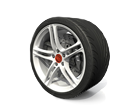8.0
pretty bad- Typical Repair Cost:
- $150
- Average Mileage:
- 64,750 miles
- Total Complaints:
- 2 complaints
Most Common Solutions:
- replace wheel hub assembly (2 reports)

wheels / hubs problem
Helpful websites
- No one has added a helpful site for this 2011 Outback problem yet. Be the first!



A D V E R T I S E M E N T S
Left rear wheel bearing started making a rubbing noise, correlated with vehicle speed. Confirmed the noise was not something else (e.g. wheels, brakes, suspension rubbing, etc.), and isolated it to the wheel bearing. This was most easily confirmed with the wheel off, and spinning the wheel hub manually, I could feel the rubbing through the hub. A normal hub would be smooth, with no rubbing or grinding. Typically, once the bearing starts making noise, it's only a matter of time before a more significant failure occurs (although it can persist with the noise for quite a while). Standard fix is to replace the hub assembly, which requires removing the brake caliber and rotor, unbolting the axle, removing four fasteners from the back of the hub assembly, then removing and replacing the hub assembly.
First challenge is that the four fasteners can be difficult to get a socket on with the axel boot in the way, so it might be necessary to remove the knuckle from the strut to get better access (should get an alignment check after this repair anyway). Second and more significant challenge is that if there is any corrosion (as usual for any but the warmest climates), that can complicate pushing the axel through the hub, removal of the four hub fasteners, and removal of the hub itself. In my case, a specialty tool called a "Hub Buster" plus multiple swings of a full length sledgehammer proved to be the easiest way to accomplish this job at home.
On this generation Subaru, removing the bolts for the front proved more challenging than for the rear, but getting the rear hub assembly removed was significantly more challenging due to greater surface area for corrosion in the rear hub assemblies. If the four fasteners are damaged at all, they will need to be replaced. Also note the service manual specifies replacing the axel nut any time it's replaced, since it is staked each time. This job is doable for the motivated do-it-yourselfer, but it is not for the feint of heart.
- Aaron K., Arlington, VA, US